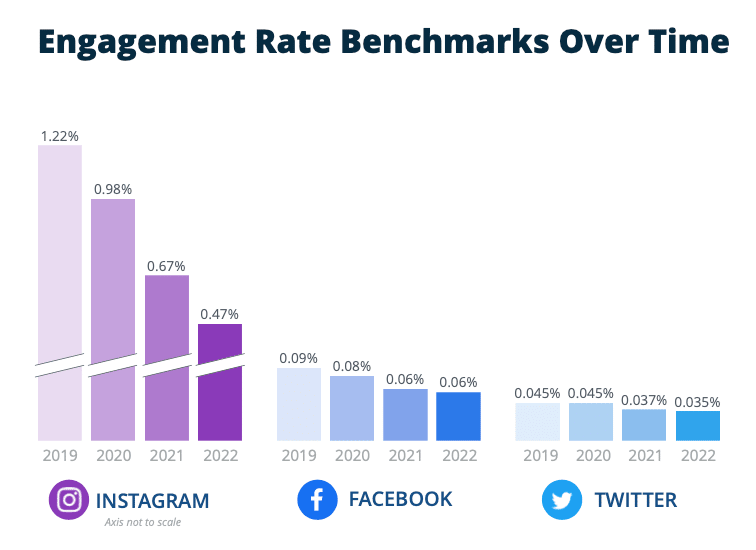Social media as we’ve known it seems to be in its dying days – with one notable exception, Tiktok. That’s according to a new social media engagement rate benchmark report.
TLDR. There are five important takeaways for brands from the 2023 Social Media Benchmark Report, which was released today by Rival IQ:
- Organic engagement: falling or flatlining. Engagement rates declined on Instagram for the third straight year but have held pretty steady for Facebook and Twitter.
- Posting frequency declining. Post frequency was flat on Instagram but took a ~20% dive on Facebook and Twitter.
- Hot holiday hashtags. Almost every industry earned top engagement rates from holiday-hashtagged posts, while contests and giveaways were less popular than in other years.
- Reels rule on Instagram. Reels dethroned carousels in multiple industries to become the most engaging post type.
- TikTok tops the charts. With a median engagement rate of 5.69%, TikTok was every industry’s best friend this year.
Why we care. The report provides valuable information that can help advertisers gauge the effectiveness of their social media strategies and identify areas for improvement. By comparing their own brand’s engagement rates to the industry averages, you can determine whether your social media performance is above or below par and make necessary adjustments to optimize their campaigns for better engagement and conversion rates.
About the report. It examined the mean engagement rates for different brand verticals across major social media networks.
It’s important to note that Rival IQ chose 150 companies, at random, from each of the 14 industries they studied, including:
- Media
- Nonprofits
- Food & beverage
- Retail
- Travel
The companies they analyzed had active presences on Facebook, Instagram, TikTok, and Twitter as of January 2022, and had Facebook fan counts between 25,000 and 1,000,000 and minimum Instagram, TikTok, Twitter followers of 5,000 as of the same date.
Interesting statistic. Among all industries, the average engagement rate for Facebook, Instagram, and Twitter never goes higher than 0.47% (Instagram). Even still, Instagram took a 30% dip in 2022 compared to 2021, while Facebook and Twitter remained flat.
The rate of weekly posts on Instagram remained steady in 2022, while it decreased on Twitter and Facebook, likely due to reduced investment by brands.

TikTok’s engagement rate, on the other hand, comes in at a whopping 5.69%. But brands are posting less frequently on TikTok than any other channel.
Higher Ed, for example, posts the least, but sees the highest engagement, whereas retail, influencers, and beauty post more frequently, but
“Higher Ed sees epic engagement rates on TikTok but is one of the least frequent posters, while Media brands’ lagging engagement rates prove once again that more posting isn’t necessarily better.”
Rival IQ
The bigger picture. Organic social, in general, has been trending downward in terms of traffic and engagement for years. Which is why brands have been flocking to TikTok (which arguably isn’t even a “social network” as it’s more about content discovery).
Enter AI. In addition to playing a key role in ChatGPT, AI and machine learning created some new possibilities for social networks.
“At first, social networks showed you stuff your friends thought was interesting — the Facebook model. Then they started showing you stuff based on the people that you chose to follow, whether you were friends or not — the Twitter model.
TikTok’s innovation was to show you stuff using only algorithmic predictions, regardless of who your friends are or who you followed. It soon became the most downloaded app in the world.
TikTok’s innovation was to show you stuff using only algorithmic predictions, regardless of who your friends are or who you follow. It soon became the most downloaded app in the world.”
Which gets us back to where we started. Facebook, Twitter and other social networks are trying to catch up (read: emulate) TikTok. Meanwhile, advertiser budgets have also followed. And TikTok continues to find new ways to improve reach for brands.
Dig deeper. You can download the report from Rival IQ here.
